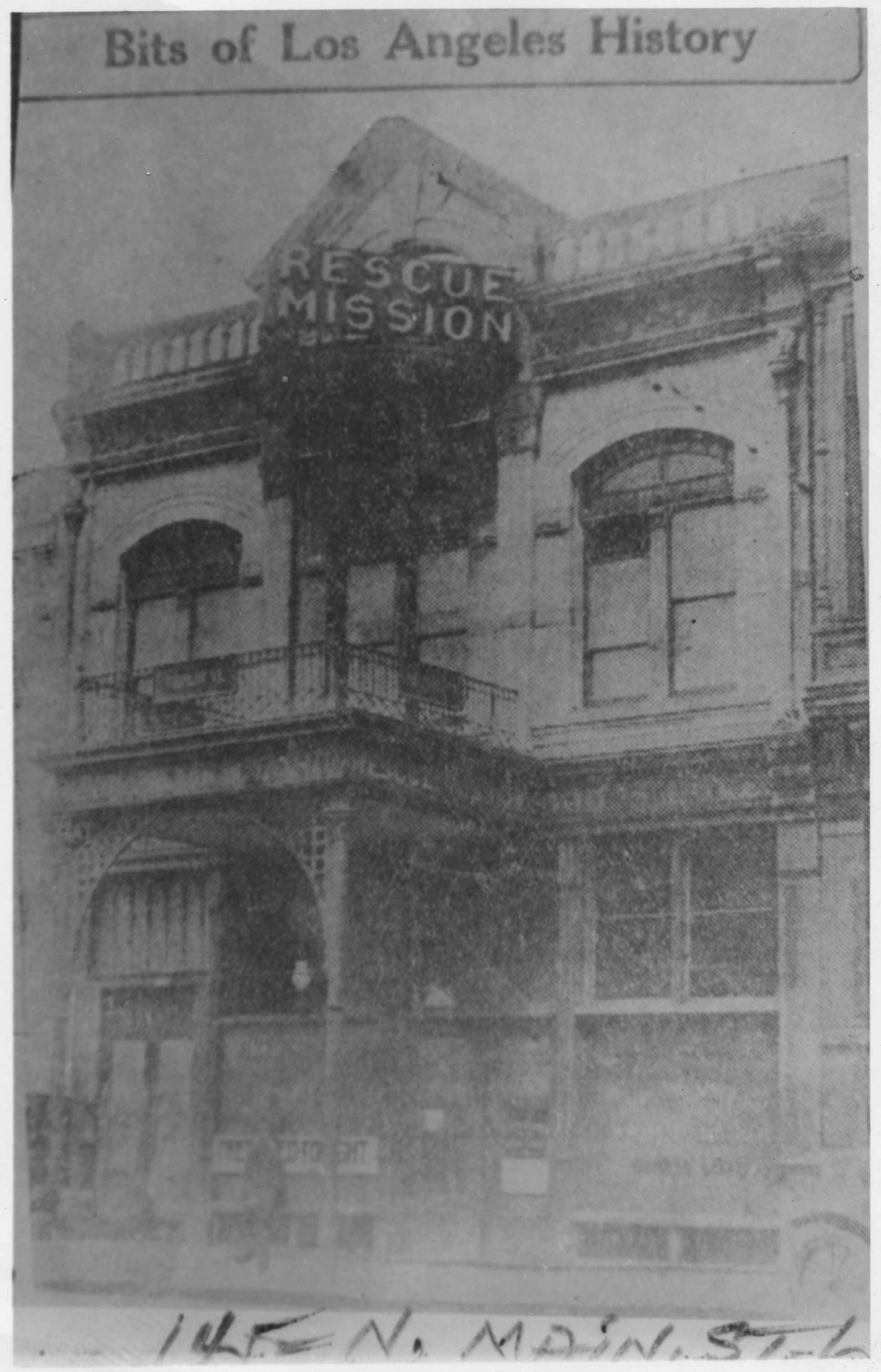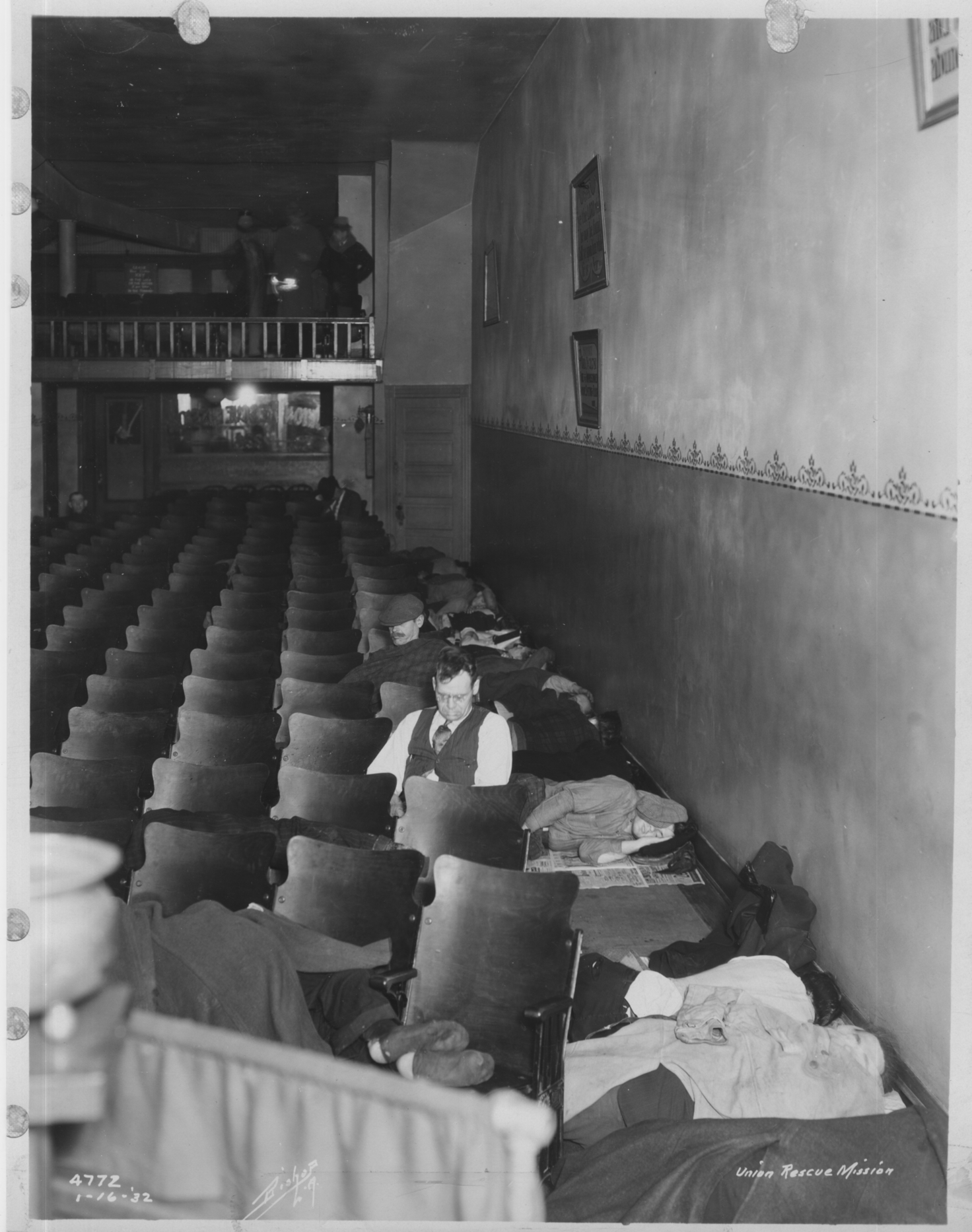It begins simply enough: as part of the ongoing project to document the forgotten history of Downtown Los Angeles, our present aim is to blog about a series of previously-unknown documents from archives of the Union Rescue Mission (URM).
We will begin by sharing some of the testimonials of faith made by those “saved” by the mission’s outreach. Each of these testimonials tells the story of a life run off the rails then back on again, and offers insights into fascinating historic subcultures which are infrequently documented.
We will also be presenting photographic documentation of the early buildings which housed the URM. These now-demolished sites will be placed in their historic and present-day contexts, to fill in some of the gaps in the century-long history of Downtown Los Angeles as a zone of poverty, addiction, redemption and transformation.
Along the way, we will introduce some of the interesting individuals whose work at the URM contributed to its mission, and uncover aspects of forgotten social history which were documented, sometimes inadvertently, by URM staff.
The URM exists to rescue men and women who have been utterly abandoned and become discouraged and helpless. It seeks to bring the gospel of Jesus Christ into their hearts, which will lead them out of temptation and to salvation. Within this lofty intent sits the more earthly goal of feeding and clothing the poor in areas which historically have been blighted, and giving them tools by which they can improve themselves.
Very quickly we already have two distinct aims by which we can distinguish and give context: that of public policy and that of Faith. These two aims cleave the problem space neatly into two parts: 1) the finite, delineated by its limited resources, clothes, energy, food, land, and those in authority who can allocate them, and 2) the infinite, that small, intangible part in all of us which is the gatekeeper to something bigger, delineated by its resources without limit: love, charity, compassion, strength. Those in authority have absolutely no control over the quality, quantity or allocation of these infinite resources.
Attempted solutions for improving the hardships faced by the poor are manifold in Southern California. They range from the official Public Policy for the County and the City of Los Angeles, Upton Sinclair’s EPIC movement, Job Harriman‘s Llano del Rio commune, the URM, and Sister Aimee Semple McPherson‘s Four Square Gospel. Note that of the solutions just listed only the first two are political, one is an attempt at a utopia, and two others come out of a literal reading of the gospel of Jesus Christ.
While the notion of a solution straddling the two kingdoms – one which feeds the stomachs and the souls of the masses – may seem fanciful, those leaders who have been most effective over the past century have had their feet planted firmly in both.
To start our exploration of the URM and the significance of its work in Downtown Los Angeles, let me lay out some important milestones in the form of dates and locations which will be helpful in understanding the context as our work begins.
- The first rented building, 2nd & Main (1896)
Operating under the name Pacific Rescue Mission, Col. M.C. Mason, since 1894 the superintendent of the Mission, rents a building (address unknown) at 2nd & Main in which to continue their good works.
Beginning in 1891, the Mission work had gone on under temporary canvas tents in the area, and on the iconic gospel wagon which traveled up and down Main and Los Angeles Streets, 1st and 2nd Streets, stopping at the many saloons along the way seeking penitent souls who wished to “go on the wagon” and dry out.
The only director listed in both the 1891 annual report and in the report for 1896 is Lyman Stewart, founder and president of Union Oil. His influence will be felt over the URM for decades.
- The second rented building, 145 N Main (1903)
Under Col. Mason’s successor, Mr. Jeffreys, a hall is rented at 145 N. Main, on what is today the lawn of City Hall. It continues to operate under the name Pacific Rescue Mission.
- Street mission, 2nd & Los Angeles Street (1907)
The Mission’s core outreach with their gospel wagon is curbed, as city ordinances are passed prohibiting street oration for the areas around 2nd & Los Angeles, and all area speaking permits are rescinded by the LAPD as well. These rules reflect the city’s public policy to curb the activisim of the emerging labor movement, with an unexpected side effect of curtailing the Mission’s work in the saloon district.
- The second rented building becomes the first purchased building, 145 N Main (1907)
After almost a decade of operating the ground floor hall in this narrow, two-storey building sandwiched between two saloons on a street of pawn shops and electric photograph parlors featuring various racy entertainments, the Mission purchases outright the building at 145 N Main, demonstrating its commitment to continued outreach to the community.
- A new name (1908)
On January 23, 1908, The Union Rescue Mission is incorporated as a California Public Benefit Corporation. Union Oil’s Lyman Stewart sits on the board of directors.
- Enter BIOLA (1908)
On February 25, 1908, Bible Institute of Los Angeles (BIOLA) is founded, with Rev. T.C. Horton as President. Horton had been on salary at URM for two years as an assistant pastor in charge of bible teaching.
Lyman Stewart of Union Oil will be BIOLA’s principal benefactor, giving the institution over a million dollars in his lifetime.
In addition to being the principal financier of BIOLA’s 1914 Italian Revival auditorium and Bible college at 550 South Hope Street (behind the Central Library), Lyman and his brother Milton would at the same time sponsor, at a cost of several hundred thousand dollars, the publication of the 90-chapter volume of scriptural study “The Fundamentals,” sent free to Christian workers all over the world.
- Exit 145 N Main Street (1926)
The City of Los Angeles finalizes its seizure by imminent domain of 145 N Main in preparation for groundbreaking on the new City Hall. With just weeks remaining before the URM must vacate, new quarters are secured just to the south at 226 S Main, next door to the Cathedral of St. Vibiana (1876).
- Public Policy and the Depression (1931)
The City of Los Angeles passes a $5 Million bond measure to create a much-needed work relief program. Although 16,000 jobs were created, the program was seen as inadequate by critics.
Los Angeles Supervisor John R. Quinn believed that there were 200,000-400,000 non-citizens living in California. If local governments could only get rid of those free-loaders, he believed unemployment would no longer be a serious issue, and crime rates would plummet. Charles P. Visel, Director of Unemployment Programs for the city began to explore the option of deportation as a solution to unemployment.
The Los Angeles County Welfare Bureau used up its entire fiscal appropriation in April. Its director requested more funds, but was denied. Upon his announcing he has no choice but to to close the department, the Board of Supervisors comes up with $250,000 to keep it afloat.
Meanwhile, the URM considers merging with BIOLA at the direction of some of BIOLA’s supporters, but ultimately the URM board resolved the issue by recognizing that the Mission is well adapted to its location on Main Street, and would best continue to serve its soul-saving purpose there.
- Public Policy and the Depression (1932)
It is estimated that 344,000 people are unemployed in metropolitan Los Angeles. The city has an $11 million deficit, and appears to be out of money and ideas. Civic leaders begin to warm to the notion that the destitute should be kept out of Southern California.
City Council passes an ordinance forbidding begging on the streets of Los Angeles. The LAPD begins to meet incoming freight trains in the city’s rail yards. The Los Angeles Chamber of Commerce recommends that the National Guard be stationed along the State’s borders to keep out undesirables.
Statistics for the Union Rescue Mission from 1932:
Meals served: 179,084
Shelter beds provided: 37,725
Baths given: 11,650
Fumigated for vermin, &c.: 470
Accounts of aid given to needy families: 225
Worship services held: 2,038
People attending the Mission’s worship services: 182,959
Professed conversions: 3,070
Gospels of John given out: 3,094
Pieces of clothing given out: 5,988
Pairs of shoes given out: 735
Number of pieces washed in laundry: 48,415
Men registered for work (Mission’s employment center): 3,314
Men found jobs through the Mission’s employment services: 493
From Oct. 10, 1932 to Jan. 23, 1933, sent 183 men to state work camps
Motto still “No Creed but Christ”
For every $7.10 spent by the Mission, a man came to ChristTotal expense $21,816.41
***
Independent of any particular location or points in time are two last important concepts: the notion of Skid Row itself as a neighborhood which has always had a rapidly changing demographic and numerous forces at work in its shaping, and the rise of Urban Redevelopment as public policy.
It is estimated that only about 5% of the homeless in Los Angeles occupy the roughly 50 square blocks of what is now known as Central City East (Skid Row). It is that concentration in such a small area which helps create the area’s unique characteristics. Skid Row is demarcated to the east by Alameda, to the west by Main Street, to the north by 2nd, and to the south by Olympic.
Post-1945, public policy in the City of Los Angeles changes dramatically. The creation of the Community Redevelopment Agency in 1949 will become the rock upon which Urban Redevelopment is built. This agency, an autonomous taxing authority, is charged with the dual—and conflicting—goals of commercial revitalization of blighted areas and the creation of affordable housing.
The CRA will be the major force driving public policy in Skid Row from the 1950s through the present day. The policy of geographical containment of the disenfranchised, the formation of housing trusts, and the 1992 relocation of the URM to its current location at 6th & San Pedro, all are the work of the CRA.
So get ready to discover the unwritten history of the Union Rescue Mission, Skid Row and Downtown Los Angeles. We’ve created a visual template to distinguish the posts which comes out of our work on the URM archives from other material presented on the In SRO Land time travel blog, and will be providing an RSS feed and a single link to the site to point interested visitors directly to the URM material.
Finally, we must express our debt of gratitude and thanks to the staff of the Union Rescue Mission, particularly to Liz Mooradian, the self-selecting keeper of the archives, and to the Mission’s CEO, Rev. Andy Bales. It is due to their support of this project and belief in the historical value of the URM’s archives that we are able to share these extraordinary documents with you now.


